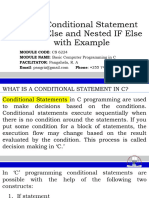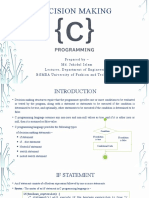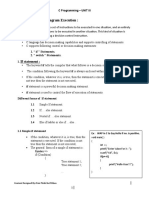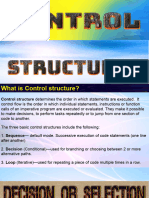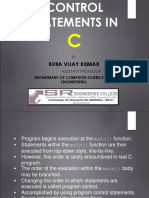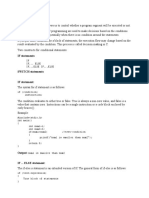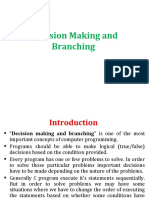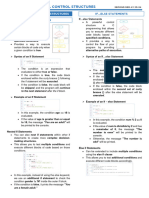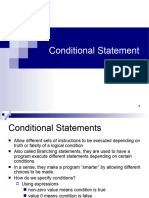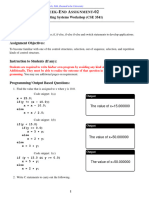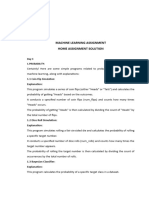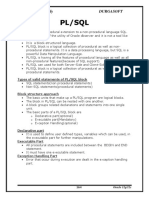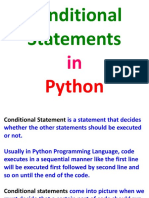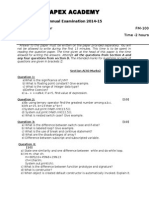Control Statements In C
Lecturer: Shimirwa Aline Valerie
Email: a.shimirwa@ines.ac.rw
Tel: 0784931189
Conditional statements in C
A Program is usually not limited to a linear sequence of The if Statement
instructions. In real life, a program usually needs to A simple condition is expressed in the form:
change the sequence of execution according to some
conditions. if (condition)
In C, there are many condition statements such as: statement;
If statement
If-else statement It starts with the keyword if; , followed by a condition
If-else-if ladder statement (a logical expression) enclosed within parenthesis,
Nested if statement followed by the result statement. The resulting
Switch Case statement
statement is executed if the condition is evaluated as
TRUE. Note that there is no semicolon (;) after the
condition expression. Consider the following example:
The if Statement cont..
By running the code in this slide, If the value of the Example 2( if statement): getting the input from the
variable “marks ” is greater than 50 , the message “You user:
have passed the exam! ” is displayed on the screen;
otherwise the statement is skipped and no message is
displayed.
Executing the program on the right side with different
inputs will behave as follows:
Case 1: Enter marks: 73
You have passed the exam!
Case 2: Enter marks: 34
Case 3: Enter marks: 50
In the second and third cases, the message “You have
passed the exam! ” will not be displayed.
The if Statement cont..
More than one statement can be executed as a result of the Example 3: program
condition by embedding set of statements in a block
(between two braces {} ).
Example 3:
Write a program which accepts a number (an amount
of money to be paid by a customer in dollars). If the
amount is greater than or equal to 1000 dollars, a 5%
discount is given to the customer. Then display the
final amount that the customer has to pay.
First the program needs to check whether the given amount
is greater than or equal to 1000; if it is the case a 5%
discount should be given. Then the final amount needs to be
displayed. All these are done only if the condition is TRUE.
So instructions which compute discount and final amount
should be executed as a block.
The if Statement cont..
Executing the program above with 1250.25 as the keyboard input
display the following: Example 4: program
Enter amount: 1250.25
Discount: 62.51
Total: 1187.74
In the program above if the condition is TRUE, the set of
statements inside the block are executed. If the condition is FALSE
(i.e., if the amount is less than 1000) those statements will not be
executed.
Example 4:
Modify Program in example 3 so that it displays the message “No
discount…” if the amount is less than 1000.
To do that, another if clause is required to check whether the amount
is less than 1000. The second if clause can be used before or after
the first (existing) if clause. Program here has been modified from
the previous to address this.
The if-else Statement
The if-else structure takes the form:
In many programs it is required to perform some action
if (condition)
when a condition is TRUE and another action when it is
FALSE. In such cases, the if clause can be used to check the true-statements;
TRUE condition and act upon it. However it does not act else
upon the FALSE condition.
Therefore the expression resulting the FALSE condition false-statements;
needs to be reorganized. In example 4 when we wanted to When the condition is evaluated, one of the two
identify the case where the amount is not greater than statements will be executed and then the program resumes
1000 (the FALSE case) we were checking whether it is less its original flow. Blocks make it possible to use many
statements rather than just one.
than 1000 <1000 ).
The C language allows us to use the if-else statement in
such scenarios. You can include both the cases (TRUE and
FALSE) using the if-else structure.
The if-else Statement cont..
Example :
Write a C program that asks the users their age, and
based on the condition, the program will display the
message to them whether they are allowed to get
married or not. The program is on the right side of
the slide.
The if-else-if ladder Statement
In certain cases multiple conditions are to be detected. In The construct in this slide is referred as the if-
such cases the conditions and their associated statements can else-if ladder. The different conditions are
be arranged in a construct that takes the form: evaluated starting from the top of the ladder and
if (condition-1) whenever a condition is evaluated as TRUE, the
statement-1; corresponding statement(s) are executed and the
rest of the construct is skipped.
else if (condition-2)
statement-2;
else if (condition-3)
statement-3;
...
else
statement-n;
The if-else-if ladder Statement
cont..
Example:
Write a program to display the student’s grade based
on the following :
If the Marks Grade
>=75 A
> 50 and <75 B
> 25 and <50 C
< 25 F
In this case multiple conditions are to be checked. Marks
obtained by a student can only be in one of the ranges.
Therefore if-else-if ladder can be used to implement
following program. The program for the example above is
shown in the figure.
conditional operator (?:)
conditional operator is also known as a ternary
operator. It takes three operands. For example:
Conditional operator is closely related
with if..else statement.
C programming Syntax of conditional operator:
Here, if x > y then printf("x is
greater") else printf("y is greater").
If the condition is true then expression1 is executed
else expression2 is executed.
conditional operator (?:)
Example:
Write a C program to check whether the student is
passed or failed using conditional operator. The
answer is on the right side of this slide.
The output of the code:
Explanation
The program checks the condition mark >=50, if it is
true "Passed“, else it prints "Failed".
This program can be simply done with the help
of if...else statement.
Switch Case Statement
• Let’s take a simple example to understand the working of
a switch case statement in C program.
Before we see how a switch case statement works in
a C program, let’s checkout the syntax of it:
Explanation of the code in this slide: In switch we
gave an expression, you can give variable also. we Output of the above code:
gave num+2, where num value is 2 and after addition
the expression resulted 4. Since there is no case
defined with value 4 the default case is executed.
Switch Case Statement
• Let’s take a simple example to understand the working of
a switch case statement in C program.
Before we see how a switch case statement works in
a C program, let’s checkout the syntax of it:
Explanation of the code in this slide: In switch we
gave an expression, you can give variable also. we Output of the above code:
gave num+2, where num value is 2 and after addition
the expression resulted 4. Since there is no case
defined with value 4 the default case is executed.
Break statement in Switch Case
Explanation of the code in this slide: we passed a
Before we discuss more about break statement, variable to switch, the value of the variable is 2 so the
guess the output of this C program. control jumped to the case 2, However there are no
such statements in the program which could break the
flow after the execution of case 2. That’s the reason
why after case 2, all the subsequent cases and default
statements got executed. How to avoid this situation?
We can use break statement to break the flow of
control after every case block.
Break statement in Switch Case
Break statements are useful when you want your
program-flow to come out of the switch body.
Whenever a break statement is encountered in the
switch body, the control comes out of the switch case
statement.
Output of the above program:
Break statement in Switch Case
cont..
Example of Switch Case with break:
We are taking the program that we have seen above
but this time we are using break statement.
Output of the program:
Why didn’t we use break statement after default?
The control would itself come out of the switch after
default that’s why we didn’t use it, however if you
want to use the break after default then you can use it,
there is no harm in doing that.
Few Important points regarding
Switch Case
1. Case doesn’t always need to have order 1, 2, 3 and so
on. They can have any integer value after case
keyword. Also, case doesn’t need to be in an
ascending order always, you can specify them in any
order as per the need of the program.
2. You can also use characters in switch case. The code
on the right side is an example.
Output of the program in this slide:
Program To Create A Simple
Calculator
Example:
Write a C program to create a simple calculator to perform
addition, subtraction, multiplication and division using
switch case statement. The code for this is on the right side
of the slide.
If-else-if vs switch case
cont..
You can use an if-else-if statement when you have
multiple conditions to check, and each condition may
lead to a different set of instructions.
It is also useful when you want to test a range of values
or conditions that can’t be expressed with a single
expression.
For example, suppose you want to determine the grade
of a student based on their marks. You can use an if-
else-if statement to check the range of marks and assign
a grade accordingly.
If-else-if vs switch case
cont..
On the other hand, you can use a switch-case
statement when you have a single expression
to evaluate against multiple possible values. It
is often more concise and readable than if-
else-if statements when dealing with multiple
options.
For example, suppose you want to determine
the day of the week based on its number. You
can use a switch-case statement to check the
number and assign a day name accordingly.
In general, if-else-if is more flexible and can
handle a wider range of conditions, while
switch-case is more concise and easier to read
when dealing with a large number of options.
Ultimately, the choice between the two
depends on the specific requirements of the
situation at hand.
Introduction to Loops
in C
Loops cause program to execute the certain block of Types Of Loops
code repeatedly until some conditions are satisfied,
i.e., loops are used in performing repetitive work in There are three types of loops used in the C
programming.
language.
Why do we use loops in C language?
1. While loop
The loop simplifies the complex problems into the
2. Do while loop
easy ones.
3. For loop
It enables us to alter the flow of the program so that
instead of writing the same code again and again, we
can repeat the same code for a finite number of times.
For example, if we need to print the first 10 natural
numbers then, instead of using the printf statement 10
times, we can print inside a loop which runs up to 10
iterations.
While Loop
The while loop in C is used in the scenario where we Flowchart Of the while loop
don't know the number of iterations in advance. The
block of statements in while loop are executed until
the condition specified in the while loop is satisfied. It
is also called a pre-tested loop.
The syntax of while loop in C language is given
below:
While Loop cont..
Example 1:write a C program that prints 1 to 4 numbers on
the screen. The program is shown here.
Output of the program:
step1: The variable count is initialized with value 1 and then
it has been tested for the condition.
step2: If the condition returns true then the statements inside
the body of while loop are executed else control comes out
of the loop.
step3: The value of count is incremented using ++ operator
then it has been tested again for the loop condition.
While Loop cont..
Guess the output of the while loop in program
here.
The program is an example of infinite while loop.
Since the value of the variable var is same (there is no
++ or -- operator used on this variable, inside the
body of loop) the condition var<=2 will be true
forever and the loop would never terminate.
Other examples of infinite
while loop
Example 1:
Example 2:
The above code has Infinite loop because variable var will
always have value >=5 so the loop would never end.
The above code has Infinite loop because var
value will keep decreasing because of -- operator,
hence it will always be <= 10.
Use of Logical operators in
while loop
Just like relational operators (<, >, >=, <=, !=, ==), below we are using two logical operators NOT (!)
we can also use logical operators in while loop. The and AND(&&):
following scenarios are valid :
You can use AND(&&) operator, which means both
the conditions should be true. For example:
below we are using two logical operators NOT (!)
and OR(||):
You can use OR(||) operator, this loop will run until
both conditions return false. For example:
Example of while loop using logical
operator
In this example we are testing multiple
conditions using logical operator inside
while loop.
The output of the program here is:
More Examples of using while loop
Example1: write a C program to print all even numbers
from 1 to n using while loop.
More Examples of using while loop
cont..
Example2: C program to find sum of natural numbers
from 1 to n using while loop.
More Examples of using while loop
cont..
Example 3: C program to print multiplication table of
a given number. For example:
Input
Input num: 5
Output
do-while loop
The do-while loop continues until a given condition
satisfies. It is also called post tested loop. It is used
when it is necessary to execute the loop at least once .
The syntax of do-while loop in c language is given
below:
The typical output of the above code:
A real-life example of when we might use a do-
while loop could be to ask a user to enter a
password, and keep prompting them until they enter
the correct password.
For loop
The for loop is used in the case where we need to execute
some part of the code until the given condition is satisfied.
The for loop is also called a pre-tested loop.
It is better to use for loop if the number of iteration is known
in advance.
The syntax of for loop in c language is given below:
Real life scenario of when to use a for loop in c:
Suppose you are writing a program in C to calculate the sum
of the first 10 numbers (1 + 2 + 3 + ... + 10). Instead of
writing out each number manually, you can use a for loop to
The output of the above code:
iterate through each number and add them up. Here's what
the code might look like:
C break and continue
In C programming, break and continue are two Below figure demonstrates How break statement
works:
keywords that are used to control the flow of a loop.
Break statement
break statement is used to immediately exit the loop.
It is typically used when a condition is met that
requires the loop to terminate early.
The break statement is almost always used with if
statement inside the loop.
Examples on how to use break
statement
Example 1: write a C Program to calculate the sum of
10 numbers from the user. If a negative number is
entered, the loop terminates.
Output of the code:
Continue statement
Below figure demonstrates How break statement
continue statement, is used to skip the current works:
iteration of the loop and move on to the next iteration.
It is typically used when a certain condition is met that
requires skipping a specific iteration.
The continue statement is also always used with the if
statement.
Examples on how to use
continue statement
Example 1: write a C Program to calculate the sum of 10
numbers from the user . and negative numbers are skipped
from the calculation
Output of the code:
In this program, when the user enters a positive number, the
sum is calculated using sum += number; statement.
When the user enters a negative number,
the continue statement is executed and it skips the negative
number from the calculation.
Nested loops In C
Below is the syntax of the nested loop:
A nested loop is a loop inside another loop. In other
words, it's a loop that is contained within the body of
another loop. The inner loop will execute completely
for each iteration of the outer loop.
Nested loops are commonly used when you need to
perform a task that requires multiple iterations. For
example, if you have a two-dimensional array, you
might use a nested loop to iterate over all the
elements in the array. The outer loop would iterate
over the rows, and the inner loop would iterate over
the columns.
Outer_loop and Inner_loop are the valid loops that
can be a 'for' loop, 'while' loop or 'do-while' loop.
The outer loop controls the number of times the inner
loop will execute.
Nested For loops In C
Nest for loop means that we have for loops inside Syntax for nested for loop:
another loop.
Example for Nested For loops
Explanation of the code
First, the 'i' variable is initialized to 1 and then program control passes
to the i<=n.
The program control checks whether the condition 'i<=n' is true or not.
If the condition is true, then the program control passes to the inner
loop.
The inner loop will get executed as long as the condition is true.
After the execution of the inner loop, the control moves back to the
update of the outer loop, i.e., i++.
After incrementing the value of the loop counter, the condition is
checked again, i.e., i<=n.
If the condition is true, then the inner loop will be executed again.
This process will continue as long as the condition of the outer loop is
true.
Out put of the code:
Example for Nested nested loops
Explanation of the code
This program uses two while loops to print out the values
of i and j. The outer while loop runs from i = 1 to i = 3,
while the inner while loop runs from j = 1 to j = 3 for each
value of i. Inside the inner loop, printf() statement prints
out the values of i and j.
Out put of the code here is:
Nested while loops In C
The nested while loop means any type of Syntax for nested for loop:
loop which is defined inside the 'while' loop.
While loop Exercises
1. Write a program in c that displays numbers from 1000
to 100 using while loop.
2. Write a program that displays all the integers from 8
to 23 (inclusive) using while loop.
3. Using while loop, write a program that asks the user
to type 10 integers and displays their sum.
4. Write a program that asks the user to type 10 integers
and displays the smallest of these integers.
for loop Exercises
1. Write a C program to print the 6. Write a C program that uses nested loops to
multiplication table of a given number up to print out a different number of stars on each line
10. The expected output:
2. Write a C program to find the factorial of a
given number.
3. Write a C program to find the sum of all
even numbers between 1 and 100.
4. Write a C program to check whether a
given number is prime or not.
5. Write a C program to print the Fibonacci
series up to a given number.
